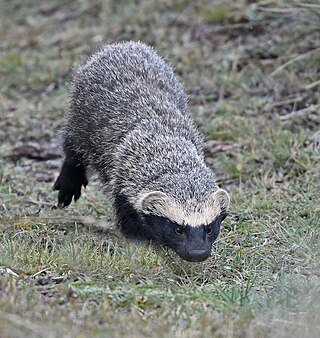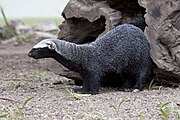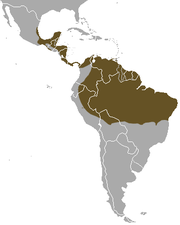
The Mustelidae are a diverse family of carnivorous mammals, including weasels, stoats, badgers, otters, martens, grisons, and wolverines. Otherwise known as mustelids, they form the largest family in the suborder Caniformia of the order Carnivora with about 66 to 70 species in nine subfamilies.

A marten is a weasel-like mammal in the genus Martes within the subfamily Guloninae, in the family Mustelidae. They have bushy tails and large paws with partially retractile claws. The fur varies from yellowish to dark brown, depending on the species; it is valued by animal trappers for the fur trade. Martens are slender, agile animals, adapted to living in the taiga, which inhabit coniferous and northern deciduous forests across the Northern Hemisphere.

The long-tailed vole, in some areas known as the San Bernardino long-tailed vole, is a small vole found in western North America. They have short ears and a long tail. Their fur is gray brown with light gray underparts. They are around 18 cm (7.1 in) long with an 8 cm (3.1 in) tail and weigh about 50 g (1.8 oz).

The crab-eating raccoon or South American raccoon is a species of raccoon native to marshy and jungle areas of Central and South America. It is found from Costa Rica south through most areas of South America east of the Andes down to northern Argentina and Uruguay. Despite its name, this species does not feed exclusively on crabs, and the common raccoon also seeks and eats crabs where they are available. In Paraguay, it is known as aguará or agoará popé from Guarani.

The greater grison is a species of mustelid native to Southern Mexico, Central America, and South America.

The lesser grison is a species of mustelid from South America.

Micronycteris is a genus of leaf-nosed bats.

Merriam's ground squirrel is a species of rodent in the family Sciuridae. It occurs in the western United States in Idaho, Nevada, and Oregon.

Galidictis is a genus in the subfamily Galidiinae of the family Eupleridae: a group of carnivorans that are endemic to Madagascar.
Interdigital webbing is the presence of membranes of skin between the digits. Normally in mammals, webbing is present in the embryo but resorbed later in development, but in various mammal species, it occasionally persists in adulthood. In humans, it can be found in those suffering from LEOPARD syndrome and from Aarskog–Scott syndrome.

Enhydrictis is a genus of extinct mustelid, belonging to the subfamily Galictinae. The type species, and best known, is Enhydrictis galictoides from the Pleistocene of Sardinia and Corsica. Some authors attribute species from mainland Eurasia to the genus, but this is disputed, with others considering the genus endemic to Sardinia-Corsica.















